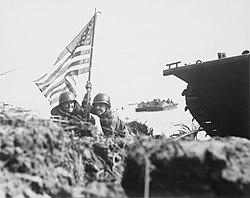
Back معركة غوام (1944) Arabic Bitva o Guam (1944) Czech Schlacht um Guam (1944) German Batalo de Guamo (1944) EO Batalla de Guam (1944) Spanish Guameko gudua (1944) EU نبرد گوام (۱۹۴۴) FA Guamin taistelu (1944) Finnish Bataille de Guam (1944) French הקרב על גואם (1944) HE
| Second Battle of Guam | |||||||
|---|---|---|---|---|---|---|---|
| Part of the Mariana and Palau Islands campaign of the Pacific Front (World War II) | |||||||
 U.S. Army officers planting the American flag | |||||||
| |||||||
| Belligerents | |||||||
|
|
| ||||||
| Commanders and leaders | |||||||
| Units involved | |||||||
| 29th Division | |||||||
| Strength | |||||||
| Casualties and losses | |||||||
| 600+ civilians killed[11] | |||||||
The Battle of Guam (21 July–10 August 1944) was the American recapture of the Japanese-held island of Guam, a U.S. territory in the Mariana Islands captured by the Japanese from the United States in the First Battle of Guam in 1941 during the Pacific campaign of World War II. The battle was a critical component of Operation Forager. The recapture of Guam and the broader Mariana and Palau Islands campaign resulted in the destruction of much of Japan's naval air power and allowed the United States to establish large airbases from which it could bomb the Japanese home islands with its new strategic bomber, the Boeing B-29 Superfortress.
- ^ Commander Joint Expeditionary Force (Commander Amphibious Forces, U.S. Pacific Fleet); United States Navy, Pacific Fleet Task Force 51 (25 August 1944). "Report of amphibious operations for the capture of the Marianas Islands (Forager Operation)". p. 6. Retrieved 24 February 2023.
This is the report concerning the major amphibious features of the operations of Task Force 51 (Joint Expeditionary Force) for the capture of the Marianas. The enclosures comprise a narrative of the operation, and a series of comments on certain technical matters which may be of interest in connection with future operations. The report includes in some detail the operations of Task Force 52 during the Occupation Phase of Saipan, and in less detail the operations of other task forces for the capture of Tinian and Guam. The reports of commanders of Task Forces 52 (No. 2), 53 and 56, and of various task group and unit and ship commanders may be expected to set forth details of the operations of their forces.
{{cite web}}: CS1 maint: multiple names: authors list (link) CS1 maint: numeric names: authors list (link) - ^ a b c Cite error: The named reference
Rottman-2004was invoked but never defined (see the help page). - ^ 2,300 police, coast defense, and anti-air, 1,800 laborers, and 1,000 miscellaneous personnel
- ^ History of U.S. Marine Corps Operations in World War II: Central Pacific Drive p. 443. Retrieved 24 February 2023
- ^ "The history of battles of Imperial Japanese Tanks". February 2019. Retrieved 24 February 2023.
- ^ Includes a "substantial" number who later died from wounds.
- ^ "The Recapture of Guam" Appendix III. Retrieved 24 February 2023
- ^ "Report on the Capture of the Marianas" 25 August 1944, Enclosure 'A' Annex 3, p. 1. Retrieved 24 February 2023
- ^ "Enclosure 'K'". Report on the Capture of the Marianas. 25 August 1944. p. 6. Retrieved 24 February 2023.
- ^ "Report on the Capture of the Marianas" 25 August 1944, Annex 3 Enclosure 'A'. p. 2. Retrieved 24 February 2023
- ^ Cite error: The named reference
Gruhl, p.101-102was invoked but never defined (see the help page).